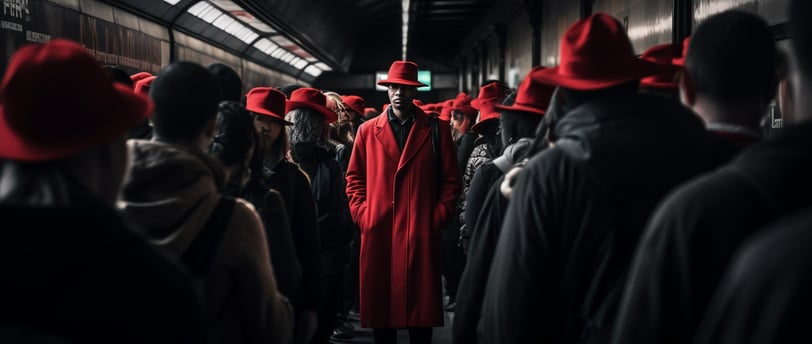Standing Out in Hong Kong’s Saturated Market: The Art of Advertising with Impact
Hong Kong is flooded with ads—so why do most go unnoticed? The secret isn’t being louder, but being smarter. Here’s how brands can truly stand out.


There’s no place quite like Hong Kong when it comes to advertising. A city where brands fight for every inch of visibility, where LED screens battle neon lights, where every street corner, taxi, and escalator railing has been claimed by an ad. But in a place where people are bombarded with thousands of marketing messages daily, has advertising lost its power?
The truth is, visibility alone no longer guarantees impact. The old rules—louder, flashier, bigger—are becoming less effective. Consumers in Hong Kong are savvier, more impatient, and less willing to be sold to than ever before. It’s not just about standing out anymore; it’s about making people care. Brands that survive don’t just find space in a crowded market—they find space in people’s lives, habits, and emotions. And that takes more than just buying ad space. It takes understanding what Hong Kongers value, how they live, and what truly moves them.
Why Being Seen is Not the Same as Being Remembered
It’s easy to think that a big-budget campaign guarantees success. You secure billboards in Causeway Bay, splash ads across the MTR, and flood digital screens with your message. But ask yourself: how many of these ads do you actually remember? The streets of Hong Kong are filled with campaigns that are expensive yet forgettable.
Take, for example, the infamous case of Victoria Harbour’s sky-high LED billboards. They dominate the skyline, screaming brand names across the water. Yet, few people can recall which brands actually advertise there. Why? Because being the biggest doesn’t mean being the most impactful. Attention is fleeting if there’s no deeper connection.
Contrast that with McDonald’s simple yet brilliant “The Moment” campaign, which featured everyday Hong Kongers in subtle, heartfelt moments—a father and son sharing fries, an exhausted office worker unwinding with a burger. It didn’t need grand visuals; it needed relatable human emotions. And that made it more powerful than any flashing neon sign.
So, before you ask how big your ad should be, ask how meaningful it is. Would it still work if it were smaller? Would people talk about it even if they weren’t forced to see it? If not, maybe the problem isn’t size. Maybe it’s depth.
The Myth of Mass Appeal: Why Hyper-Localization Wins in Hong Kong
Hong Kong isn’t just one market—it’s many micro-markets compressed into one dense, vertical city. The way an ad resonates in Mong Kok isn’t the same as in Central. A message that works for luxury shoppers in Pacific Place won’t work for the late-night crowd in Tsim Sha Tsui.
Yet, many brands still treat Hong Kong as one homogenous audience, running generic campaigns that miss the nuances of local culture, humor, and language. The brands that win are the ones that understand Hong Kong at a street level.
Nike’s district-specific ads were a masterclass in this. Instead of rolling out a single campaign, Nike created ads tailored for each area—showcasing Mong Kok’s street basketball culture differently from the running trails of Bowen Road. Each ad felt native to its environment, making it feel like part of the city, not just another brand screaming for attention.
Localization goes beyond just translating slogans. It means knowing the daily struggles, aspirations, and attitudes of Hong Kongers. It means capturing the small moments that define life in this city, like the thrill of catching the last minibus home, or the unspoken rule of never taking the first cha chaan teng seat offered to you. If an ad can nod to these moments, it earns something money can’t buy—authenticity.
Experiences Over Exposure: The Future of Advertising is Not an Ad
Ask anyone in Hong Kong if they remember a billboard they saw last week. Then ask if they remember an event or an experience they participated in recently. You’ll see the difference.
People forget ads but remember experiences. That’s why some of the most successful brand activations in Hong Kong don’t even feel like advertising.
Take Lululemon’s interactive wellness pop-up in PMQ. Instead of just promoting yoga wear, they created an entire experience with meditation pods, fitness classes, and personalized brand engagement. The result? People didn’t just see the brand; they lived it.
Contrast that with a digital banner ad. How often do people willingly engage with one? Would they take a screenshot of it? Would they tell a friend about it? Would they spend time with it if they weren’t forced to? If the answer is no, then why are brands still spending the majority of their budgets on traditional ad formats?
In a city where people crave novelty, exclusivity, and shareable moments, an immersive event will always be more powerful than a passive ad. The future belongs to brands that create something worth experiencing, not just something to look at.
The Attention Economy is Broken: Engagement Beats Impressions
It’s never been easier to buy views. With AI-driven ad placement, brands can now reach millions of Hong Kongers in seconds. But does reach equal impact?
Take the case of digital ads that interrupt instead of engage. Most people skip them. Some even install ad blockers. Brands invest in exposure but rarely stop to ask—did anyone actually care?
Contrast that with Cathay Pacific’s loyalty program ads, which use AI to tailor personalized travel offers based on a customer’s previous trips. Instead of just flooding screens with promotions, the brand makes people feel like they’re receiving a curated experience.
Would you rather spend millions forcing ads onto screens people don’t want to see—or invest in content they actively seek out?
Final Thought: Advertising in Hong Kong is Not About Being Loud. It’s About Being Smart.
The brands that will win in Hong Kong’s hyper-competitive landscape aren’t necessarily the ones with the biggest budgets—but the ones that understand the city best. The ones that realize Hong Kongers don’t want more advertising; they want better advertising.
Being seen is easy. Being remembered is hard. And being truly loved by consumers? That’s the real challenge.
So, the next time you launch a campaign, don’t just ask:
"How many people will see this?"
Ask: "How many people will truly care?"
Because in Hong Kong, the most powerful advertising isn’t the one that’s the loudest—it’s the one that actually matters.
chat@helloching.com
© 2025. All rights reserved.
